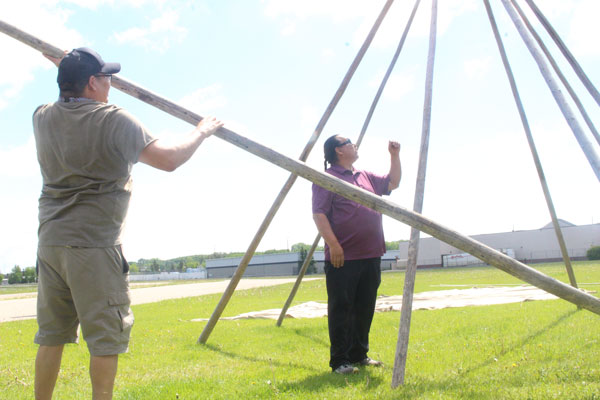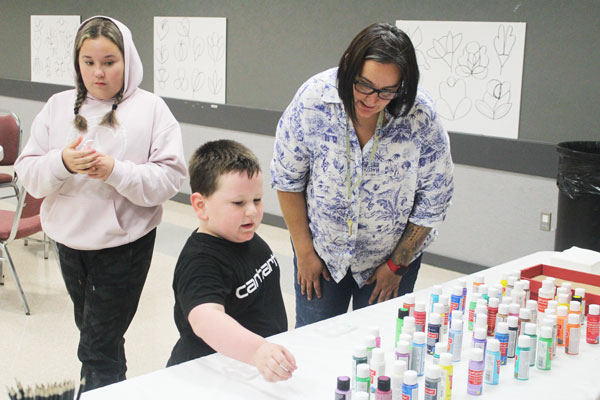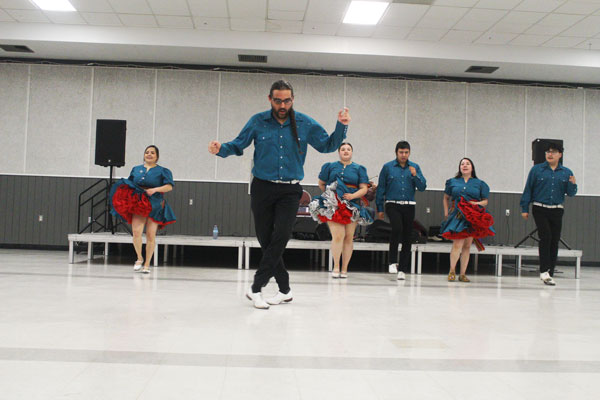
There were many opportunities for cultural learning on Saturday, June 15 at the Prince Albert Exhibition Centre as part of the second annual Northern Prairie Indigenous Peoples Collective Summer Solstice.
The event drew in artists from multiple disciplines with the goal of educating local youth. The event began with a tipi raising Saturday morning led by Bil Waditaka from Wahpeton.
“We say it’s a home for our First Nations relatives,” Waditaka explained. “We’ve been known to pick up and move to different locations and throughout the summer and throughout the year. That’s what we do, so these are made to be put up and taken down quite quickly.”
PAGC Urban Services lent the event a teepee and Waditaka thanked them for the assist. He created a new flap using a tarp and a sewing machine.
Everyone who took part in the raising also learned about tipi teachings through a handout.

Jennifer Brown taught about Metis pointillism art at the second annual Northern Prairie Indigenous Peoples Collective Summer Solstice at the Prince Albert Exhibition Centre on Saturday, June 15.

The Northern Prairie Dancers entertained and gave lessons about Metis jigging at the second annual Northern Prairie Indigenous Peoples Collective Summer Solstice at the Prince Albert Exhibition Centre on Saturday, June 15.
Waditaka said it’s important to give people opportunities to learn more about Indigenous culture.
“If I can say anything to anybody, (it’s) continue learning,” he said. “Continue learning where you are.
The tipi raising was one of several educational workshops available for attendees. Others included a teaching about pointillism led by 2023 Prince Albert Women’s Hall of Fame inductee and prominent Metis artist and teacher Jennifer Brown.
Brown said pointillism was originally developed in France by George Seurat. It involves laying dot over dot of paint to create layers.
“Christi Belcourt, who’s the pioneer in Metis pointillism painting, wanted to replicate beadwork,” Brown explained. “The whole goal is that each dot should be raised so you have that tactile touch, that you would get from beadwork.”
Brown said the unique thing about it is that depending on the size of the dot, you can change where the feel and texture is.
“It’s one art form that blind people can enjoy not knowing the colors, but they’d be able to tell the difference between the size so that they could trace out each of the flowers,” she explained.
Brown spreads the joy of pointillism wherever she can.
“I like to consider myself the affordable Christi Belcourt,” she said.
Belcourt has done work with high end fashion designers, but Brown said the goal on Saturday was to introduce people to the basics.
“It was a market that I wanted to share with people,” Brown explained. “She (Belcourt) created beautiful pieces of art that kids can replicate. They just need the time and the patience.”
Brown added that children sometimes lack both the patience and the ability to take time to create. Once they get into it, however, they enjoy it.
“It’s very calming and very relaxing, because it’s just a small repetitive piece after each,” she said. “I’ve done this at probably 10 different schools in Prince Albert and all of the kids want me to come back because it’s just quietly enjoyable.
“It’s very calming. Beading is a little bit different because that’s calming and relaxing. The downfall is you’re constantly jabbing your thumb. Here, there’s no jabbing your thumb, so I think that’s why people are able to enjoy it a little more. The downfall is when you drop your hand you can smear everything.”
Pointillism involves dropping very tiny beads of paint. Brown said many people incorrectly think they should use a Q-tip. Instead, she recommends a stylus, which is meant for clay.
“It has a very tiny metal point, but even at the smallest you can make the largest hole,” she explained. “You’d fill up your paint. It’s going to look like it’s going to fall off and you just touch down and lift up and each time it’ll make a raised dot.”
She added that you can feel each raised dot.
“It’s a neat little tactile art, and once you get into color sorting, that’s where the stress comes because kids are never sure what color they want to pick or which color will work best with which one.”
Brown said colour matching is a skill most people think they do not have, but discover they do when they see colours together.
“I enjoy it a lot,” she said. “It’s stressful to teach it because you never know if somebody’s going to make a mistake, and then (it’s) how can you fix it and how quickly can you fix it, but we try our best.”
Saturday’s event was held in mid-June because that’s when Summer Solstice occurs in the northern hemisphere.
The event not only helps educate youth about Indigenous culture, it also gives them and their families a chance to connect with the community. Organizer Janice Henry told the Hearld that many of the families who take part are not originally from Prince Albert, so the Summer Solstice event helps them get involved in the community.
Other events included learning about jigging from the Northern Prairie Dancers and First Nations dancing from the Thundering Sky Dance Troupe. These two groups closed the afternoon before supper with entertainment and lessons.
michael.oleksyn@paherald.sk.ca

